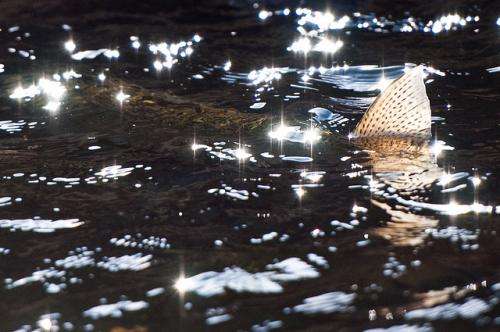Hidden physics make fish glitter

A theory borrowed from physics to understand how electrons move in semiconductors may explain the silvery mirror-like appearance of many fish, recent research suggests.
Scientists from UWA and the University of Bristol (UK) believe Anderson Localisation, a theory of how waves travel through disordered structures, fills gaps in our previous understanding.
The research is based on the physics of how light travels in a stack structure containing layers of different materials.
Depending on the wavelengths of light involved, and how the layers are stacked, a variety of optical properties can be created.
In fish, these layers are composed of cytoplasm, which has a refractive index similar to water, and plate-like guanine crystals, which have a much higher refractive index, UWA Professor Julian Partridge says.
"Despite guanine and cytoplasm being transparent on their own, when appropriately organised, they create interference between the light waves passing through them, resulting in stunning visual effects," he says.
"Depending on the wavelengths of light involved, and how the layers are stacked, a variety of optical properties can be created, including both coloured and silvery reflections."
Anderson Localisation extends to other marine species
Prof Partridge says applying Anderson Localisation explains the optical properties not just of fish skin, but also of the mirror-like appearance of some squid, insect exoskeletons and the eyes of spiders.
He says the research came about because of his nagging doubts about the standard 'quarter-wave stack' models of animal reflectors.
"These models were great for highly-coloured iridescent reflections, such as are found in some fish skin, but they didn't explain how a fish could be silvery," Prof Partridge says.
"Highly-coloured iridescence means only a small part of the spectrum is reflected, but silvery reflectors must bounce back light of many wavelengths; that doesn't happen with a quarter-wave stack.
"Worse, the simpler models predicted multilayer reflectors would always be highly polarising, like light reflected from the surface of still water, when I knew that many silvery fish did not polarise light."
Prof Partridge says fish manage to be silvery, instead of coloured, by having just the right amount of disorder in their multilayer stacks.
"They are unpolarised because they use guanine crystals that have different refractive indices in different directions," he says.
"This sort of structure is best explained by the mathematics of Anderson Localisation."
So from now on, when someone asks why sardines and many other fish are silver, the answer lies hidden in the equations of modern physics.
More information: "Disordered animal multilayer reflectors and the localization of light." DOI: 10.1098/rsif.2014.0948
Provided by Science Network WA



















